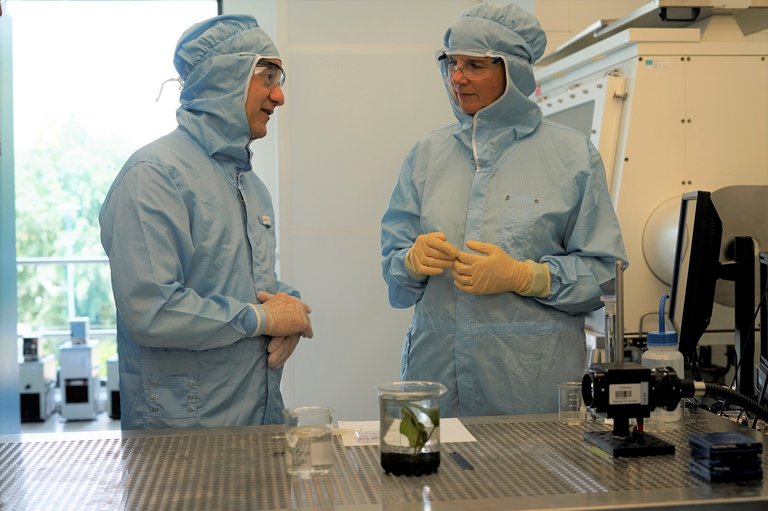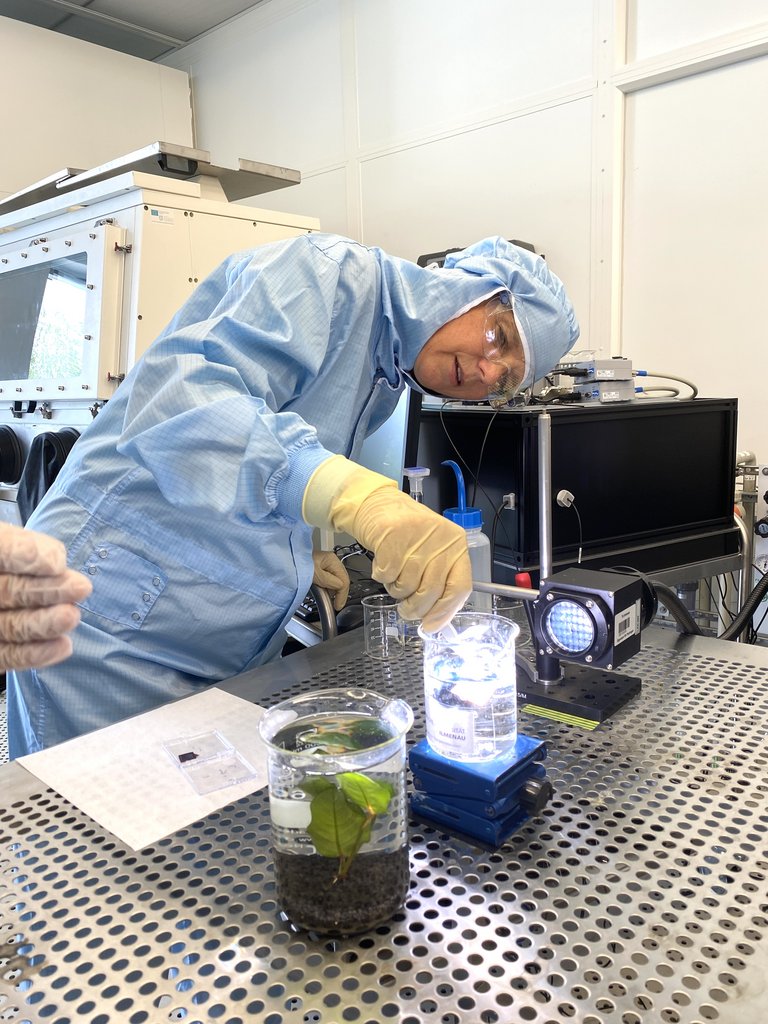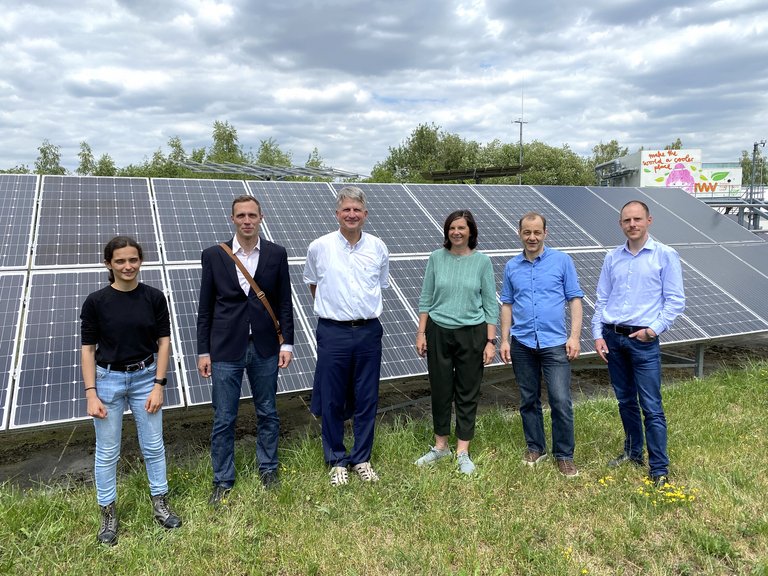How can we meet the challenges of the energy transition? What contribution can Thuringia and the TU Ilmenau make to climate protection and sustainable power generation based on renewable energies? And what is the current state of research on direct solar hydrogen production, so-called artificial photosynthesis? Vice President of the German Bundestag and Member of Parliament for Thuringia Katrin Göring-Eckardt discussed this yesterday with Vice President for Research and Young Scientists Prof. Stefan Sinzinger, Prof. Thomas Hannappel, Head of the Group for Fundamentals of Energy Materials, and other scientists from TU Ilmenau. "It is impressive to see that there are already solutions and ideas for many challenges of the energy transition. TU Ilmenau is making an enormously important contribution to further advancing these solutions," said Göring-Eckardt.
Thinking along transformation paths: Vice President of the Bundestag Katrin Göring-Eckardt catches up on the state of energy research at the TU Ilmenau

During a tour of the Center for Micro- and Nanotechnologies (ZMN), TU Ilmenau's largest technological center for basic and applied research in materials science, among other areas, the member of the Bundestag learned from Prof. Thomas Hannappel in particular about the current state of research for efficient, direct solar hydrogen production, also called 'Sunlight to X', 'photoelectrochemical hydrogen production' or 'photocatalytic water splitting' - an area that is currently being intensively researched internationally. Prof. Hannappel:
In this research field, we are at the forefront of research together with a wide variety of research groups at TU Ilmenau and outstanding national and international partners

In order to convert sunlight into hydrogen and to be able to produce the fuel of the future as cheaply and with as little effort as possible in the future, scientists in the center's laboratories and clean rooms are imitating photosynthesis with the help of semiconductors, so-called "artificial leaves". Prof. Hannappel used an experiment to demonstrate exactly how this works: if the thin semiconductor is held in an aqueous solution and the cells are irradiated with light, bubbles containing hydrogen and oxygen rise. With this technology, the Ilmenau scientists and the international research team have already achieved so-called 'solar-to-hydrogen' efficiencies of over 19 percent, making them current world record holders. This means that almost 200 watts of energy in the form of hydrogen can be generated from 1000 watts of solar energy with the help of the artificial leaf. Prof. Hannappel: "Our goal is to continue to get to the bottom of this technology. We still lack a lot of understanding of the highly complex components. We may be able to talk about industrial maturity in ten to fifteen years. In any case, we are excellently positioned here at TU Ilmenau for this research and development direction, both experimentally and in terms of scientific strategy." In order to research further challenges such as tandem structures as well as interfaces, in particular the solid-liquid interfaces of semiconductors, the TU Ilmenau is planning, among other things, to set up a collaborative research center, into which the scientists have already put a lot of energy and time.
Also discussed during the visit to the ZMN were technologies that address the increasing consumption of energy and resources brought about by the digital revolution and the increasingly widespread use of electronics and artificial intelligence, so-called green electronics. They form another focus of basic research at the ZMN.
A charging infrastructure independent of the grid and fed purely from renewable energies
Later, the vice president of the Bundestag visited the outdoor testing and experimental facility (OPAL) for research and teaching on photovoltaic components and systems, a research focus of the TU Ilmenau at the Thuringian Energy Research Institute (ThEFI). The network of 13 university departments combines the TU Ilmenau's scientific expertise in energy and environmental technology in an interdisciplinary manner. Prof. Karl Worthmann, deputy director of the institute, presented among other things the project Microgrid Research and Experimentation Platform for Future Grids - MIGRO:
The number of electric vehicles is steadily increasing. The German government's goal is to put at least 15 million fully electric passenger cars on Germany's roads by 2030. Emissions in transport are to be reduced by at least 65 percent compared to 1990 and by at least 88% by 2040. Larger parking lots such as those on the campus of TU Ilmenau must therefore be equipped with an appropriate charging infrastructure in the future
says Prof. Worthmann. With the MIGRO research project, the TU Ilmenau will be starting the first field test in July for a charging infrastructure that is independent of the grid and fed purely from renewable energies without long-term energy storage, so that an effective but comparatively inexpensive alternative would be created.
In this project, as in many others at TU Ilmenau, research groups from different university departments are working together in an interdisciplinary way, according to Prof. Albrecht Gensior, head of Power Electronics and Controls in Electrical Power Engineering. As an example, he cited the development of a resource-efficient energy distribution network for Germany based on direct current and tailored to the increasing decentralized generation and use of renewable energy. In the VERNEDCT project, which is funded by the Carl Zeiss Foundation, a total of six groups at the TU Ilmenau collaborate across disciplines. Among other things, the Group for Media Research and Political Communication is investigating the acceptance of the new technology among the population and in companies, so that the transformation path is already being considered at the societal level during the development phase. Katrin Göring-Eckardt:
We are experiencing that the energy transition is not only about the technical side, but also about communication about what this means for each individual. The TU Ilmenau is thinking about precisely this from the very beginning, with a wide variety of departments working together and communication also being part of this network.


